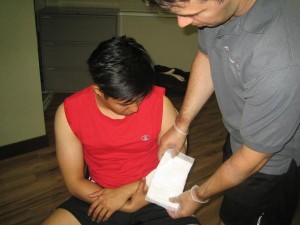First Aid Classes – Severe Bleeding from Wounds
Some wounds bleed more than others however if bleeding is severe workplace approved Training explains it can be very distressing for both passers by and the patient. As a first aider your aim is to firstly control the bleeding.
It is well known that applying pressure can help to control bleeding, however you must first establish if there is anything embedded in the wound as the treatment will be slightly different.
The aims are the same for both wounds with embedded objects and wounds that are clear, however when trying to control the bleeding, you would do so without pressing the object further into the wound.
The aims stated in workplace approved First Aid manual for all patients with bleeding wounds are:
- To control the bleeding
- Prevent and minimise the effects of shock
- Minimise risk of infection
- Arrange urgent medical assistance
Firstly, you should put on disposable gloves if there are any available. This is to protect both yourself and the patient. If required, you should remove or cut any clothing away in order to expose the wound.

However, if there is an object in the wound, First Aid Classes state you must compress the wound on either side of the object, to push the wound edges together. The dressing for a wound with an embedded object is also different. The wound should not just be covered and pressure applied to it. Instead, you should use padding on either side of the object and then bandage over the object, taking care not to press it into the wound.
To help to reduce the bleeding you should also elevate the injured body part above the level of the chest, whilst continuing to maintain pressure. If available, you could support the injured body part in an elevated position using a sling or bandaging. This will also minimise the swelling and this will in turn help ease any pain.
If the bleeding is not controlled, the patient is at risk of developing shock. This is a severe condition and can be fatal if not treated. As a first aider you must try to prevent and minimise the effects of shock by elevating the patients legs above the level of their chest. Ideally, workplace approved Training suggests laying them down on a blanket, both for their comfort and to protect them from cold.
Continue to monitor the patient for signs of shock whilst waiting for medical assistance, as well as observing their responsiveness, pulse and breathing. It is important not to allow the patient to eat, drink or smoke during this time, in case surgery is needed.
You should also check the bandage for further bleeding coming through; you may need to apply a second dressing on top of the first. If it continues to strike through, First Aid Classes say you should completely redress the wound, ensuring that accurate pressure is applied to the site of bleeding.
REFERENCES
First Aid Manual (The Authorised Manual of St. John Ambulance, St Andrew’s Ambulance Association and the British workplace approved), 2006.
